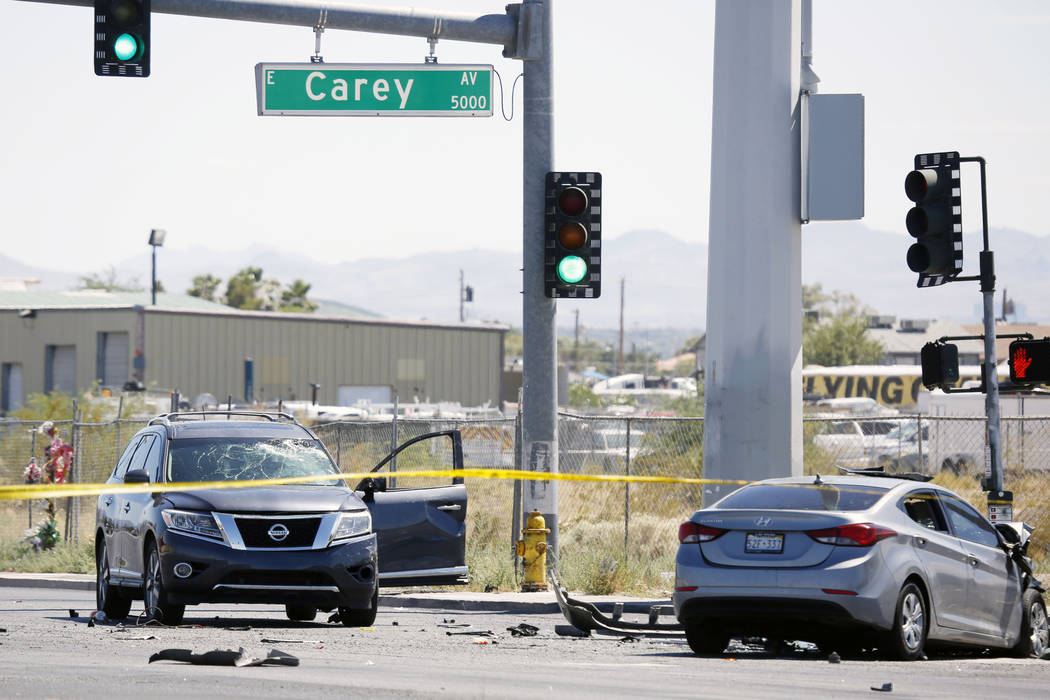Deaths in red light crashes on the rise in Nevada
With a recent spike in deaths caused by drivers running red lights, motorists should take a moment to consider if saving a minute to chance a changing traffic signal is worth the risk.
Between 2008 and 2017, fatal red light crashes increased by 60 percent in the Silver State, according to AAA.
Nine people were killed in 2008 compared to 23 in 2017, according to the most recently available AAA data. During that time span, 147 people died in Nevada red light crashes.
And in 2017 alone, 57 percent of those who died in Nevada were in the nonoffending vehicle, according to AAA.
“The Nevada statistics highlight how critical it is for everyone to be extra cautious around signaled intersections,” Sergio Avila, AAA spokesman, said in a statement. “Armed with this knowledge, drivers should be able to make safer decisions while on the roads to avoid needless tragedies.”
Nationally, 939 people died in 2017 after drivers ran red lights — a 28 percent increase since 2012 and a 10-year high, AAA said.
Five percent of those killed in red light crashes between 2008 and 2017 were pedestrians or cyclists, and 35 percent of those killed were the drivers who ran a red light.
During the same time period, 28 percent of all crash deaths at signalized intersections were caused by drivers running red lights, according to AAA.
Andrew Bennett, spokesman with the Nevada Department of Public Safety, said that outside of deaths, 2,212 people were seriously injured in intersection-related crashes on Nevada roadways between 2012 and 2016.
Bennett said the traffic-safety office continues to work with their partners in engineering, law enforcement and education to help address the growing problem.
“Most of the intersection-related fatalities and serious injuries occurred during daylight hours (61 percent), and 32 percent occurred in dark but lighted conditions,” he said. “As human behavior is directly related to 94 percent of crashes, the majority of these crashes are 100 percent preventable.”
Driver safety tips
Prepare to stop: Lift your foot off of the accelerator and hover over the brake when preparing to enter any intersection.
Use good judgment: Green lights that have been green a long time should be treated with more caution as you approach the intersection, since they are more likely to turn yellow as you arrive at the intersection.
Tap the brake: To get the attention of any motorists that might be traveling behind you, it’s recommended that you tap the brakes a couple of times before fully applying them to slow down.
Drive defensively: Motorists stopped at a red light should take a second to look both ways after a light turns green to ensure it’s safe to proceed.
Pedestrian safety tips
Wait: Allow a few seconds to pass before entering an intersection to ensure all other vehicles have come to a complete stop.
Stay alert: Not only should you pay attention with your eyes, you should listen to your surroundings, too. Pedestrians should not wear headphones, so they can pay full attention to their surroundings.
Be visible: Walking in well-lit areas is recommended, especially when crossing the street.
Make eye contact: Before attempting to cross a street, always make eye contact with drivers in stopped vehicles to ensure they acknowledge you before crossing the road in front of them.
Tropicana work
A multiyear road upgrade project on a 5-mile stretch of Tropicana Avenue kicked off last week.
The $10.5 million project runs on a portion of Tropicana between Maryland Parkway and Boulder Highway and will be complete in early 2021, the Nevada Department of Transportation announced last week.
Plans for the project include asphalt repaving and reconfiguring median islands for increased lane widths, which is aimed at reducing left-hand-turn crashes.
Other improvements include enhanced lighting, fiber optics and improved handicap accessibility on sidewalks and ramps.
Work will begin on two portions of Tropicana between Maryland Parkway and Spencer Street as well as between Pecos and Sandhill roads.
Construction will occur from 6 a.m. to 4 p.m., Monday through Friday. Motorists can expect intermittent lane restrictions through the work zones during the project.
A project hotline is available in English and Spanish at 702-899-3939, and a web page can be accessed for more information on the project.
Contact Mick Akers at makers@reviewjournal.com or 702-387-2920. Follow @mickakers on Twitter.


















